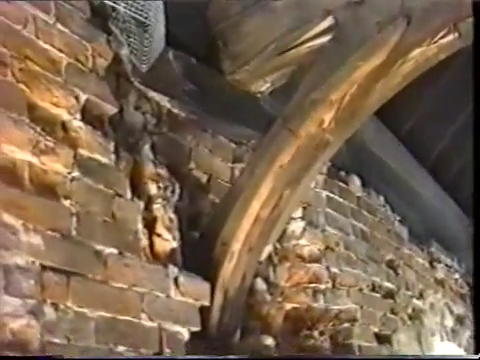The next time I stepped into that building, it was August 11, 1974. This was my first-ever visit to a Quaker meeting. The entrance was on the building's east wing, and the room we met in was much smaller than the main hall, although more than adequate for the worshipers that Sunday morning. Chairs were arranged in two concentric squares facing a table in the center. On the table were a Bible and a copy of Christian Faith and Practice. A tree limb in the rough shape of a cross was mounted on one wall.
I've described that first experience of Friends elsewhere, so here I'll just say I knew immediately that I'd found my spiritual home. As I plunged into the life of the meeting, I could see that the main hall of the old building was impractical for the Friends community, but was a resource for community involvement and rental income. The Maranatha group, a charismatic fellowship, met in that hall, and so did the Metropolitan Community Church, serving the LGBTQ community. The Great Canadian Theatre Company used the hall temporarily at one point. In any case, the space didn't go to waste.
However, the increasing costs of that property forced the meeting to think about other alternatives. One of the meeting's members, John Leaning, was an architect, urban planner, and author of what became known as the Leaning Plan. This was a proposal to adjust traffic patterns in the meeting's neighborhood, the Glebe, to increase its livability as a community. For Ottawa Friends, he headed up a project to convert most of the building into two residential condominiums, while still retaining adequate space for the meeting's own purposes. On my visits since then, I've been intrigued by how well this co-use of a single building seems to work.
Has your meeting or church tried a similar experiment? How has sustainability impacted your property decisions?
Years later, when I moved to Richmond, Indiana, I became part of another Quaker meeting with a significant property-related challenge.
We became members of First Friends Meeting (formally Whitewater Monthly Meeting of Friends), housed at the "cathedral" on East Main Street between South 15th and South 16th streets. It was a cathedral in two senses: it was built as the meetinghouse for Indiana Yearly Meeting, and it was cavernous. The balcony seating alone was bigger than many Friends meetinghouses.
However, thanks to the friendly community inhabiting that space, I soon got used to the scale, and felt very much at home. Our children treated the place as an extension of their own home, playing on and under the meetinghouse benches with no unnecessary awe of the place's size and grand history. So it was that they, and we, felt shaken when the city's engineer informed us that we had until winter to find another place to meet -- the roof supports over the main meeting room were so fragile that they could collapse without warning.
 |
| 1997: First Friends Meeting's building as demolition begins. Source. |
 |
| Ken Sherer on one of the fatal flaws: "This anchor has lost nearly all its support." Screenshot from this video. |
The decision to sell the old property, knowing it would be demolished to make way for retail space, was not easy. The old meetinghouse was a significant part of the cityscape of downtown Richmond. Several local preservationists pleaded with us to reconsider our decision, but their pleas did not come with funding.
Looking toward the future, we considered ways to meet that didn't involve property, such as meeting in a theater or auditorium or in smaller groups at different locations, but all these alternatives were either impractical or too divisive. Finally, we found unity around a proposal to build a modest, functional building on existing Quaker property, the Friends Fellowship Community retirement campus.
To build a new meetinghouse as economically as possible, the meeting asked the architect and the contractors to design ways of incorporating volunteer labor wherever possible. The architect, Jack Hodell, was already well acquainted with Friends culture. As the building neared completion, members of the meeting gave many hours of work in painting, finishing, and landscaping. The meetinghouse that resulted had no claims to cathedral grandeur, but was simple, beautiful, and serviceable.
 |
| The new meetinghouse, with a partial view of solar panels. Source. |
In the old Yearly Meeting cathedral, the roof turned out to be the weak point. Maybe the new roof's value as power source is a just compensation.
How has your meeting or church ensured that your property (if any) serves you rather than the other way around?
Quaker experiments, part one.
Related:
Trustworthy, part four: churches' choices
Where should we meet?
Newspaper story about First Friends' solar project.
What lessons are we being taught about Queen Esther?
The case for Norman Borlaug as a Lutheran saint.
The inside story of how Harry Potter was translated into Yiddish.
In case you need a summary of today's developments in the USA's continuing descent into authoritarianism.
Domingo Samudio (Sam the Sham) and the original Pharaohs, hosted by Mike Douglas. (Yes, it's true. At one time I had every single Sam the Sham album!)

No comments:
Post a Comment